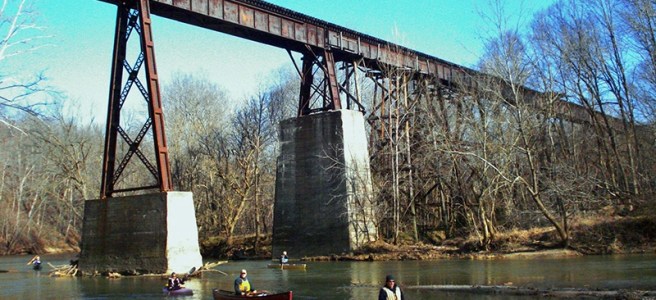
Let’s catch up.
On February 13, 2017, a Monday and the last day of a 3 day weekend, 13 year old Abigail Williams and 14 year old Liberty German were best friends, and being young teenagers, they wanted to try to fulfill their local rite of passage — walking across a disused, very tall railroad bridge.
Like most teens their age and of their time, they lived on their phone. They used Facebook and Snapchat, iMessage and texts, but also the Health app on the iPhone 6S they were using that day. They both had log-ins on that phone, and that phone still used a fingerprint. It would unlock to both of Libby’s thumbs and one of Abby’s fingers.
The Monon High Bridge crosses Deer Creek in western-central Indiana. It’s not the wealthiest part of a relatively poor state, but it’s as comfortable as possible. It’s a small town, big enough for a good pharmacy, some serious industry, a full school district of its own. Like most of the Rust Belt, Delphi, Indiana is struggling with alcohol and drugs, unemployment and underemployment, a very old tax base with far too many accumulated costs resulting in high property taxes on declining value. The climate is changing, and Emerald Ash Borers are destroying one of the cash tree crops, the American Ash. Farm land is consolidating under those with the credit to buy, leaving more and more families as farm renters or not really making it at all. The population is aging, it’s harder to keep labor and delivery units in hospitals, but geriatrics is one of the few growth industries, from home care and assisted living to nursing homes.
Delphi is not a town my family ever lived in, but it’s not much different from the small Indiana towns my parents fled when I was a child, and to which I returned over the years. I drove through Delphi more than a few times, especially in the years when Abby and Libby were still in elementary school. It’s beautiful and hard, it’s survived booms and busts and floods and droughts, but each one wears down its resilience. It’s mean and kind, it’s like every other small town in the region, and all of them tear up or drive out the vulnerable.
That morning, Libby’s dad made the girls banana pancakes, Libby’s older sister agreed to drive them to the trailhead and Libby’s dad would pick them up after they crossed it, when they called him. Everyone expected a couple hours. It was about 44 degrees Farenheit, which two little girls relished as the first nice, pleasant day after a grey winter. Libby’s sister sent them off with at least an extra sweatshirt to keep them warm.
The bridge is about a half-mile east by southeast from the trailhead that’s right next to Indiana 25, the Hoosier Heartland Highway. Hoosier, by the way, is what residents of Indiana call themselves, and it’s a cultural marker of note. The Monon High Bridge is about 65 feet tall, runs east-west, with the trailhead about a mile west of the bridge’s western entrance, and is the second highest trestle bridge in the state of Indiana. It was a rail line, but has been abandoned. As a railroad bridge, it is not paved. You walk on the ties across the bridge, and you can see between them. There are no side rails, and the spaces between the railroad ties feel wide enough to fall through. They’re mostly not that wide, but they sure feel that way. The bridge is in poor condition. The limestone pilings are crumbling, the metal parts are rusty and failing, and the wood ties are not going to last forever.
For young teenagers? It’s a marvelous adventure and a relative safe way to be terrified. It’s an accomplishment and a test of bravery to walk across it. Adults mostly don’t. Most teenagers cross slowly, until the very end when the anxiety and relief and the growing safety can spur someone into a jog. Some people get scared and cross it on their hands and knees. And that’s okay. It’s a scary bridge. Most importantly, it’s not a bridge that’s easy to run across. Most people cross it at one mile an hour or less, because it will not allow for recklessness or carelessness. Each step must be taken mindfully.
For those of us of a certain age, the railroad bridge in Stand By Me is a good mental image of abandoned rail bridges in the Midwest.
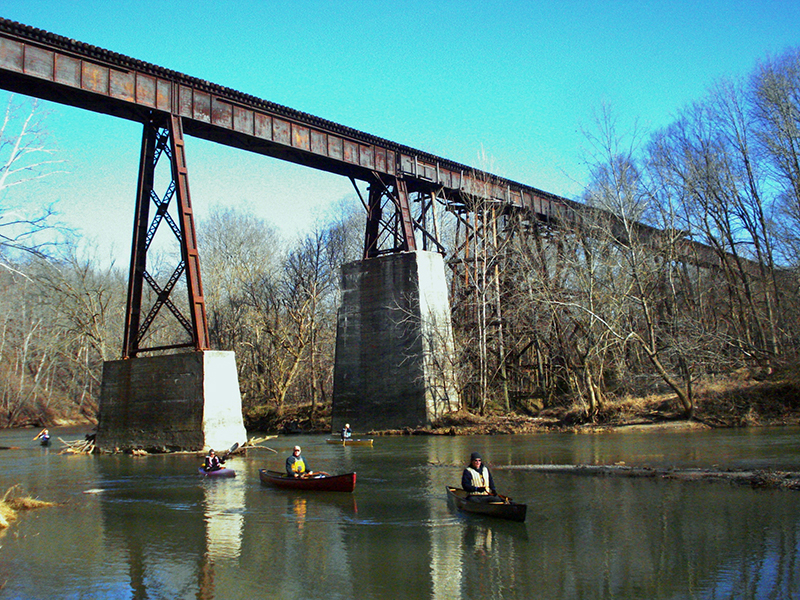
And that’s what Abby and Libby did that day. They made it across the bridge. They took pictures and a Snapchat when they were almost fully across on the eastern end. In the background of their Snapchat, there was a dark, vaguely male shaped figure, probably 80 feet or so away, on the bridge, near the other side. Out of earshot, especially because there was an 8-10 mph wind that day.
When a short video taken from that Snapchat was released soon after that day, the police had blown it up, enhanced it, rotated it, and stabilized the image. It gave the impression that the distant, vaguely male shaped person was very close to the girls, but in the whole video, the person is not close. The whole video has only just been shown to the jury and has never been shown to the public. Reports from inside the courtroom state that the public press stills and video gave a dishonest impression of the events on that day. And this trial matters, most especially in what it is concealing. This trial is barely open to the press, not being streamed, recording of all kinds is forbidden and the only notes allowed are hand-written in this Year of Our Lady Beyoncé 2024. This trial is being conducted in darkness and secrecy.
That press release video also indicated that an indistinct sound recorded on the phone came from that male figure, but there’s no way that figure crossed that much distance in the few seconds possible. The voice isn’t that loud. And what it says is a matter of conjecture and interpretation. It’s really not clear enough to be distinct, per witnesses in the courtroom. It might be an imperative, “guys, down the hill.” That’s what the prosecution wants everyone to think, that the phrase was the inciting event of kidnapping. Or it might be a warning, “[there are] guys down the hill.” Or just a friendly question, “[You] guys [been] down the hill[?]” There’s not enough to really gauge.
We don’t know much about that figure. It’s vague and distorted thanks to being a frame in the background of an iPhone 6 short video that was none too steady in Libby’s hands, of someone moving in the background while the camera tried to focus on someone in the foreground (most likely Abby), while the background figure was also moving, and it has been over-manipulated. No frame is clear. The figure appears to be wearing a blue Carhartt-type jacket and jeans. Maybe a hood from an olive or brown hoodie, maybe a hat. Or just weird hair. He’s kind of bulky, but adults wear more winter clothing than young ones. Maybe has a fanny pack/belt bag at his waist. Doesn’t appear to have facial hair. Might have a scarf. Hands in his pockets, looking down because he’s walking on railroad ties, and even if you can’t fall between them, you can trip, and then you’re likely to fuck up a knee or ankle or wrist. The manipulation has left the figure oddly foreshortened, almost smushed.
However, a little good trigonometry and some data gathering on the scene would have allowed a video analyst to get some excellent height and weight information, because he’s standing on fixed size railroad ties. It’s possible to figure angles and figure out if he really is closer to a Tolkien or Pratchett sized dwarf, or a big, burly guy stumping along, doing slightly less annoying exercise than a treadmill. Or identifying marks of a predator.
That option was available to the police. They chose not to pay for that analysis, because they were told there would be some variation, +/- 2 inches. Because knowing if someone is 5’8” to 6’, average 5’10” versus knowing if someone is 5’3 to 5’7”, average 5’5” was too much uncertainty for a police department determined to do it themselves.
The witnesses who maybe saw this guy all described him as a Big Guy, not “a short but wide guy” or “burly” or bearish. Big guy. For most people, that means at least tall and broadly built. It almost never means short and broadly built, because a short man is memorable. Then, they would have likely said, “short, but big.”
Of course, the witnesses all saw different clothes — black jackets, nondescript canvas jackets closer to khaki, grey — so if they were even seeing the same person is unclear at best.
There is a myth that the park was remote. It is not. There are houses and farm buildings within a few hundred yards in most directions. There’s a county road not much more than a quarter mile north. At least 70 people were in the park that day. A speaking voice cannot be heard over 80 feet or more, but a child’s scream carries for a good mile. Especially over leafless winter trees and a creek bed. As a park it feels more remote and scary than it really is.
But for Abby and Libby, it was deadly for them that day.
We don’t know what happened, but the phone has some records. We do know that at 2:05 pm, Libby posted on Snapchat a photo of the empty bridge. That’s about 25 minutes after they left Abby’s sister’s car at 1:41.
At 2:07, the phone was unlocked again.
At 2:13, Libby took the 43 second video of Abby on the bridge that showed the figure in the far background, and a fairly nearby voice said some variation of “guys down the hill.”
The next minute, the phone failed to unlock to a fingerprint.
At 2:18, 2:25, and 2:32 the phone registered movement — walking. After 2:32, the Health app never again recorded movement.
At 5:47 pm, the phone pinged the tower, but apparently received nothing. And someone inserted a plug into the headphone jack, presumably a set of headphones.
One report said it pinged the tower again at 10:32 pm, one didn’t have that report. And at that time at night, someone removed the headphone jack. That’s not an artifact of software, that is a hardware manipulation that can only be performed by human hands.
In the most recent analysis of the phone’s data, the phone hit the tower at 4:33 in the morning of the next day, February 14, and downloaded the whole bolus of frantic text messages, missed calls, and iMessages from those searching for Abby and Libby.
For Richard Allen, his day started with his parents, 38 miles and 40 minutes away, in Peru, Indiana. This town, I do know; it’s where one set of my grandparents lived. It’s a dying town that deserved better than it’s getting. Richard Allen is 52, and I have a good reason to believe he and I went to the same elementary school, and he was a few grades ahead of me for the year I was there. He graduated from the associated high school. (I don’t think I met him since big kids don’t really associate with little ones and he wasn’t on my bus.)
When he recounted his day years later, he remembers that he left his parents house around 11:15, which put him back in Delphi around noon; he stopped at home for a jacket and then went back out to the park for some of the grudging exercise a middle aged man with a cardiac history will do. He walked out, he stood on a fishing platform and looked at the fish, he did a little day-trading on his phone because everyone’s got a hobby, turned around, went back without crossing the bridge (which as stated above is more terrifying the older you get and the less immortal you feel). He saw a group of three girls, one of whom seemed a bit older and was maybe watching out for the younger ones. He walked back to his car, went about the rest of his day. His car was caught on a local store’s security camera at about 1:30.
A woman who also walked the trail most days saw his car, and then when she came back to that parking area, she didn’t see it anymore, and that was at around 2:15. How long ago he left, she couldn’t say, but he wasn’t there at 2:15.
About 3:10, Libby’s dad called the phone; they didn’t answer. He called again, no answer, so he started looking for them.
Another woman was on the bridge about 3:45, taking pictures. She didn’t see the girls or anyone else. She didn’t hear anything. She has photos of the bridge and the creek. There is no blood in the water, there are no clothes in the flow.
Weeks later, a woman claimed that, shortly before four pm, she was driving at 35 miles per hour on the county road on the north side of the park and saw a man walking on the side of the road that she thought was muddy the first two times she recounted her event. On the third time, she stated he was bloody. To be clear, most Indiana dirt is dark brown to black. Very little is reddish, so mud and blood don’t look much alike.
Also around 4, Libby and Abby’s family start an informal search party, and an hour later, at 5:20, they called the police and report them missing.
Sunset on 13 February, 2017 started at 6:20 with twilight ending at 7:53. Delphi is rural enough that it doesn’t have a city glow, and the park is wooded, so darkness was coming fast.
No Amber Alert was sent for the girls that night. There was AN Amber Alert, for another girl up in Gary. Totally unrelated, but the girl in Gary was considered to be in extreme danger, so the Indiana State Police would have focused their attention on that girl and that car. Why the Delphi Police didn’t add their own Amber Alert is an unknown, but possibly rests in the fact that they didn’t think Abby and Libby were in danger of anything worse than hypothermia or maybe a broken ankle. And because they didn’t have anything for people to watch for — no suspect car, no known threats. But do keep it in mind — nobody learned anything from an Amber Alert, because one didn’t exist. Nobody learned anything from the evening news, because the girls weren’t on it that night. At best, they heard some community gossip or saw something on their social media.
For the rest of the night, volunteers and police and fire all searched for the girls. The girls weren’t considered to be endangered, except by the elements, since it was supposed to dip into the 20s overnight, and the girls were only wearing jeans and sweatshirts.
At around 1:30 in the morning on the 14th, the Be On the Look Out (BOLO) for Abby and Libby went out. A helicopter with night vision looked for them; dogs were called for, but hadn’t arrived yet.
The sun rose at 7:41, and the search was back on by 10 in the morning. EMS staged a lot of their equipment and personnel on the north side of the park, along county road W 300 N, for easier access to that half of the woods. Scores of volunteers were in that patch of woods, and their intentions were excellent. Nobody could know that they might be obscuring evidence or leaving their own.
Shortly before noon, someone found a black Nike that belonged to Libby in the creek, and within a few minutes, another searcher found them, about a half-mile west and slightly north of the bridge, AND on the opposite side of the creek they were on after crossing the bridge.
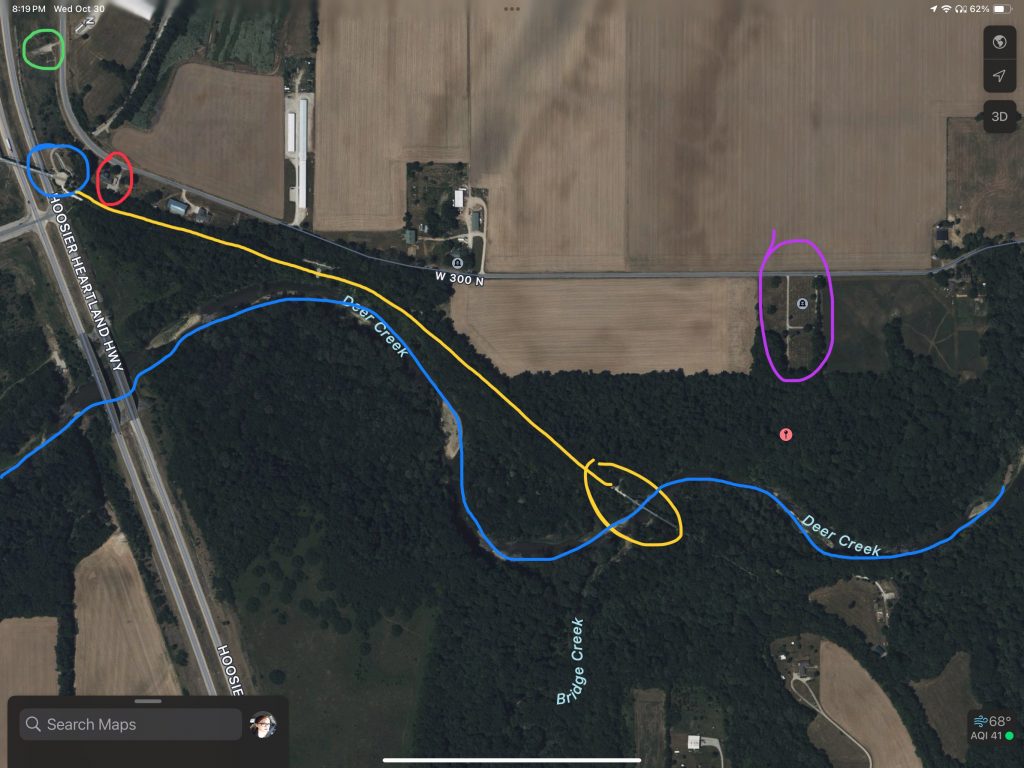
For the next couple of days, the police and evidence experts focused their attention on the crime scene, mostly using the cemetery and the field as their staging and entry area. Ergonomically, it’s the most sensible way into the area.
The scene itself was terrible, and it wasn’t revealed to the public how terrible for a couple of years. But Libby’s phone was recovered that day, and the image that came to be known as Bridge Guy as well as the “down the hill” audio clip were released within the first week.
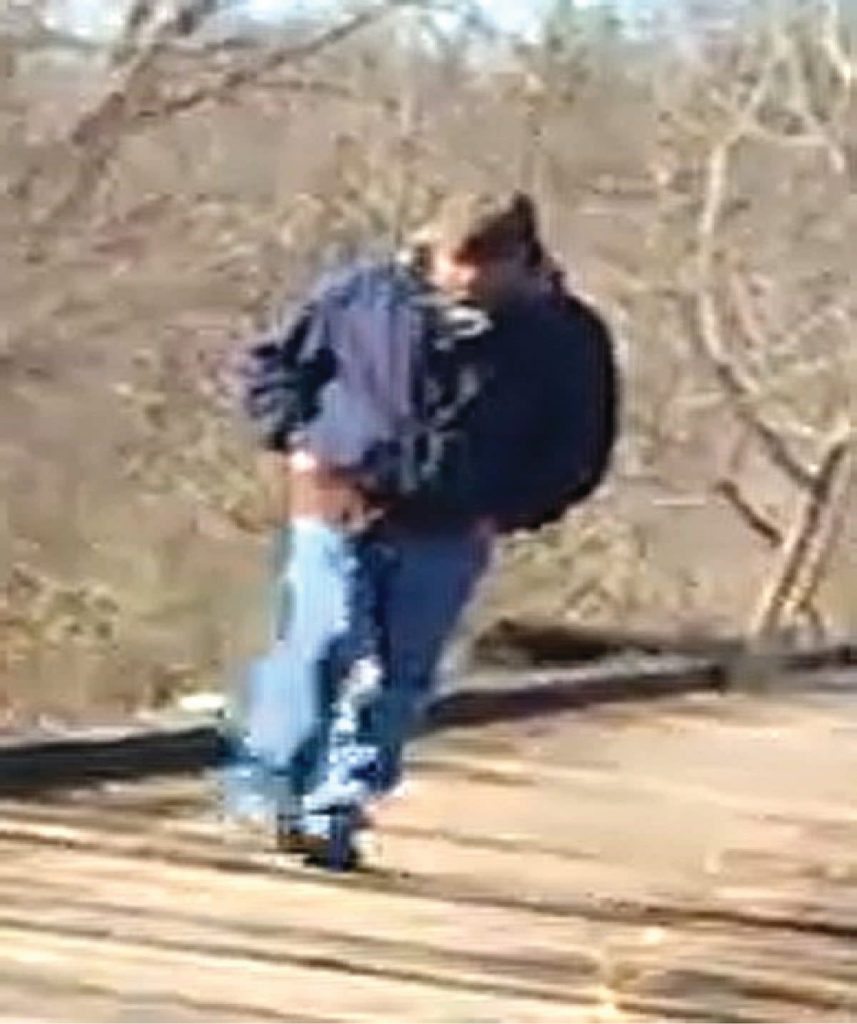
Again, the description of Bridge Guy would come to matter. With some math, most experts who saw the bridge guy image estimated the person’s height at around 6 feet tall, possibly a bit more. This aligns with witness accounts, who all called him a Big Guy. However, the police themselves never paid for that analysis, so it was neither official evidence nor anything they used as a descriptor. At the time the image and audio file were released, the police cautioned that they couldn’t assume the image and the voice were connected, or even the same person, or that the person had anything to do with this murder. They would slowly forget these distinctions as time passed. They initially released one sketch, and then a second one, of a younger man with curly hair.
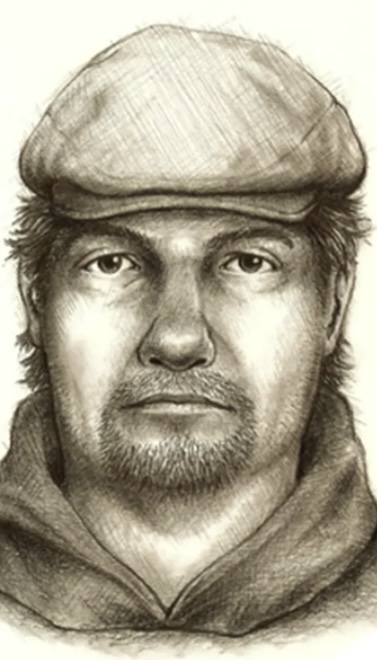
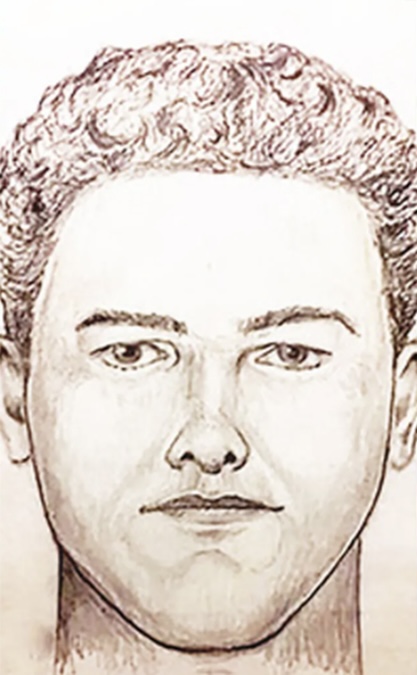
They arrested one person early on, Ron Logan, who owned land that abutted the park, the land where the girls were found. He owned a 40 caliber hand gun, he was a tall, broad, hard working farmer with a difficult history with women and girls, a history of drinking and recklessness, and had been shady about interacting with the police. To be fair, he had not had great relationships with cops before, and now they were being aggressive towards him. Ron is now dead, but he was released as cleared early in the investigation. That may have been a serious mistake.
The Delphi police and Indiana State police and the FBI would receive upwards of 50,000 tips in the next few weeks. At some point, the FBI was either told to remove themselves or just frozen out by the locals. And over the next several months… the trail went cold. Abby and Libby were buried, their friends and family built memorials for them, and Delphi learned to live with this hole.
Three cops from other agencies continued their own investigation, cooperating with each other and refusing to get married to any specific theory. They found multiple leads, significant circumstantial evidence, and were pretty close to a solid solve. The retired assistant chief of police of Rushville, IN, Todd Click, applied his experience and resources to the case. He had a suspect in Rushville that coincided with a significant part of the Delphi case. He, and his colleagues Detective Kevin Murphy and Detective Greg Ferency spent much of 2017 and 2018 establishing an alternate theory of the case and detailed information regarding suspects, focused on a white nationalist hate group that uses Norse pagan trappings to dress up their violent racism.
When they attempted to present this information to the prosecutor in 2022, they were completely ignored. The Defense only learned about it when they were given the discovery documents (late, and poorly organized.)
But, also, almost nothing happened until 2021-22. The case mostly went cold. There were a couple of small press releases, but also remember that the Delphi police had decided to release as little information as possible about the case, the crime scene, the information they had. The full snapchat video was never released, nor any audio. The public didn’t even know the girls’ manner of death until 2022. They were just dead, and it was a bad crime scene, but the Delphi Unified Command, as they called themselves, kept silent about everything except the girls’ names, facebook pictures, and ages.
Back in 2018-ish, the Unified Command realized they needed someone to organize all of the tips and documents they had received. Note also that they had, between state and federal grants, about $4 million to see this case through, so hiring a full time professional was not out of budget. That’s a $50-60K job for rural Indiana. IU, Perdue, and Notre Dame all produce library science graduates every year, and the librarian job market can be less than hot.
Instead, they cheaped out and brought on a nearing retirement age volunteer with no information science or data science skills to organize, scan, and enter all of those documents into a database. They abused her labor for years. It took her two years just to scan everything in. (And when we get to trial, they’ll throw her under the bus and blame her for any lost document or video, even though they were losing stuff before and long after she wasn’t involved, too.)
Next time…
In 2022, the investigation revealed they had a new investigative direction, but didn’t give any details about it. A member of the Unified Command and Delphi municipal police officer, Tony Liggett, decided to run for Sheriff of Carroll County. It was going to be a tough fight.

Be First to Comment